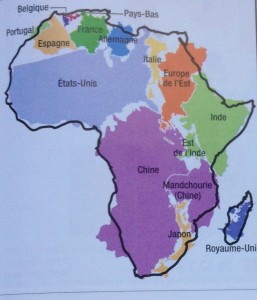Le Logiciel Libre au Québec
 Depuis 2009, l’organisme FACIL, avec l’appui de nombreux organismes de la communauté du logiciel libre au Québec, organise presque à chaque années l’événement SQIL (Semaine québécoise de l’informatique libre). Il s’agit d’une série d’activités ayant pour objectif de promouvoir l’utilisation du logiciel libre et des données ouvertes. Il y en a pour tous les niveaux: pour les débutants, comme les plus expérimentés.
Depuis 2009, l’organisme FACIL, avec l’appui de nombreux organismes de la communauté du logiciel libre au Québec, organise presque à chaque années l’événement SQIL (Semaine québécoise de l’informatique libre). Il s’agit d’une série d’activités ayant pour objectif de promouvoir l’utilisation du logiciel libre et des données ouvertes. Il y en a pour tous les niveaux: pour les débutants, comme les plus expérimentés.
Cette semaine offre de nombreuses activités, notamment conférences, ateliers, rencontres, projections de films, tables ronde et plus.
« L’informatique libre au service d’une société libre » est le thème de l’édition 2016 de la SQIL.
Pour sa 8e édition, le SQIL 2016 aura lieu du 17 au 25 septembre 2016 dans plusieurs villes à travers le Québec, notamment Québec, Montréal et La Pocatière.
Logiciel Libre = Providence technologique
Le fait qu’il y ait des méga-corporations avec quasi monopole dans l’industrie des technologies de l’information et des communications peut porter atteinte au recherche et développement de nouvelles percées technologiques dans le domaine.
C’est là que l’informatique libre intervient : le plus gros réseau de recherche et développement du monde. En effet, quel secteur d’activité ne requiert pas d’infrastructure informatique ? Aucun ! Qu’arrive-t-il aux entreprises qui n’intègrent pas de solutions informatiques ? Elles auront plus de difficultés à gérer leur croissance face à la compétition.
Si ces entreprises, consortiums et organismes travaillent main dans la main pour développer de façon collaborative des solutions informatiques que n’importe qui pourra utiliser, contribuer, modifier et redistribuer librement, qu’est-ce qu’on gagne au final ? L’indépendance dans les technologies de l’information et des communications.
Imaginons la PME qui doit renouveler ses licences pour ses postes informatiques à chaque année, suite bureautique, logiciels d’inventaire, de serveurs, de base de données, et engager un expert certifié. Pour la plupart des PME, il s’agit d’un coup dur à prendre. Nous parlons de PME, mais le coup peut être dur à prendre aussi pour les grandes entreprises, pour les gouvernements, même pour les particuliers.
 Un exemple parfait d’informatique libre que vous connaissez sans doute: Wikipédia! Tout le monde a l’autorisation de lire, contribuer, modifier et redistribuer gratuitement son contenu, mais aussi les logiciels sur lequel il fonctionne (Mediawiki, Linux, etc.)
Un exemple parfait d’informatique libre que vous connaissez sans doute: Wikipédia! Tout le monde a l’autorisation de lire, contribuer, modifier et redistribuer gratuitement son contenu, mais aussi les logiciels sur lequel il fonctionne (Mediawiki, Linux, etc.)
L’informatique libre est là pour que, plutôt que tout le monde travaillent en cachette – chacun dans leur coin – sur des technologies équivalentes, que ce soit la même technologie pour tout le monde; tout le monde travaillent en équipe sur une architecture flexible, concrète et universelle pour atteindre plus rapidement des objectifs communs. Il s’agit là d’alliance stratégique. Que ce soit le secteur médical, gouvernemental, militaire, commercial, institutionnel ou autre, le logiciel libre ne peut apporter que des avantages.
On ne bâtit pas une civilisation extra-terrestre en développant nos technologies en cachette chacun de notre côté et en brevetant tout et n’importe-quoi ; on bâtit une civilisation extra-terrestre en partageant notre savoir et nos connaissances.
L’informatique libre ne consiste pas seulement en des logiciels libres, mais aussi au matériel libre, la culture du libre, les standards ouverts et consortiums, la confidentialité et la protection de la vie personnelle, la neutralité du réseau internet, l’égalité sociale dans la société numérique et encore plus…
Pourquoi le logiciel libre est important?
L’informatique fait désormais partie intégrante de la société d’aujourd’hui et personne ne peut le nier. Au même titre que les besoins essentiels (eau, nourriture, électricité, chauffage, transport etc.), l’informatique est maintenant un pilier indispensable au plein fonctionnement de l’économie internationale et à la paix sociale.
Lorsqu’un organisme, ou un particulier, achète un logiciel, ne pas avoir le droit d’accéder au code source et d’y apporter les modifications désirées est non seulement contre-productif, mais aussi cela ne respecte pas les droits de l’utilisateur. Lorsque l’utilisateur n’a pas le contrôle sur le logiciel, c’est le logiciel qui a le contrôle sur l’utilisateur.
Si le logiciel n’est pas open source, le fournisseur peut accéder à tous vos fichiers, accéder à votre localisation géographique, espionner votre microphone et webcam, en collaboration avec un gouvernement ou non, et ce, sans que vous le sachiez.
Si le logiciel est open source, mais pas libre : vous pouvez savoir s’il comporte un logiciel espion, mais si vous souhaitez adapter ce logiciel aux besoins de votre entreprise et y contribuer, ou en faire la distribution de service, vous n’en aurez pas l’autorisation.
Le logiciel libre est important parce qu’il respecte vos libertés fondamentales en tant que citoyen ou en tant qu’organisme, c’est-à-dire votre confidentialité, votre indépendance et celles de vos données, votre liberté, votre culture de la connaissance générale et votre accès à l’information. Tout ça est respecté!
Horaire des activités du SQIL 2016
La SQIL favorise la convergence des mouvements pour le logiciel libre, le matériel libre, le savoir libre et la culture libre au Québec. Tout ce qui peut se mettre sous une licence libre et participe à la construction, au développement et à la conservation des communs numériques est à l’honneur ! Célébrons nos ressources partagées !
Que vous soyez un étudiant, un professionnel ou fanatique de l’informatique, un utilisateur normal d’ordinateur ou un hacker, débutant ou expérimenté, vous trouverez un événement qui vous intéressera.
Vous êtes invités à participer en grand nombre aux activités de la SQIL 2016 !

*****
Vous aimez cet article!
Faites une DONATION à notre rédaction par un clic au bas de la colonne de droite de cette page... MERCI!




 Depuis 2009, l’organisme FACIL, avec l’appui de nombreux organismes de la communauté du logiciel libre au Québec, organise presque à chaque années l’événement SQIL (
Depuis 2009, l’organisme FACIL, avec l’appui de nombreux organismes de la communauté du logiciel libre au Québec, organise presque à chaque années l’événement SQIL ( Un exemple parfait d’informatique libre que vous connaissez sans doute: Wikipédia!
Un exemple parfait d’informatique libre que vous connaissez sans doute: Wikipédia! 


